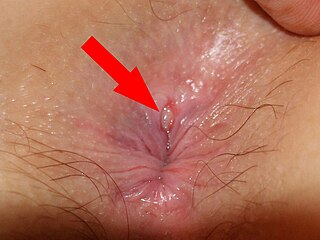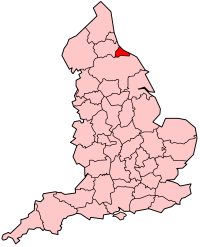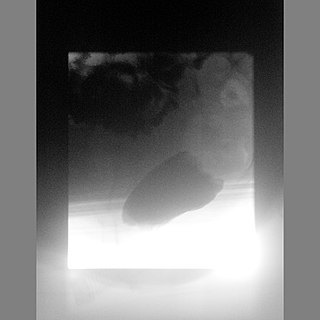Related Research Articles

The gastrointestinal tract is the tract or passageway of the digestive system that leads from the mouth to the anus. The GI tract contains all the major organs of the digestive system, in humans and other animals, including the esophagus, stomach, and intestines. Food taken in through the mouth is digested to extract nutrients and absorb energy, and the waste expelled at the anus as faeces. Gastrointestinal is an adjective meaning of or pertaining to the stomach and intestines.

Defecation follows digestion, and is a necessary process by which organisms eliminate a solid, semisolid, or liquid waste material known as feces from the digestive tract via the anus or cloaca. The act has a variety of names ranging from the common, like pooping or crapping, to the technical, e.g. bowel movement, to the obscene (shitting), to the euphemistic, to the juvenile. The topic, usually avoided in polite company, can become the basis for some potty humor.

The hymen is a thin piece of mucosal tissue that surrounds or partially covers the vaginal opening. A small percentage are born with hymens that are imperforate and completely obstruct the vaginal canal. It forms part of the vulva and is similar in structure to the vagina. The term comes straight from the Greek, for 'membrane'.

Constipation is a bowel dysfunction that makes bowel movements infrequent or hard to pass. The stool is often hard and dry. Other symptoms may include abdominal pain, bloating, and feeling as if one has not completely passed the bowel movement. Complications from constipation may include hemorrhoids, anal fissure or fecal impaction. The normal frequency of bowel movements in adults is between three per day and three per week. Babies often have three to four bowel movements per day while young children typically have two to three per day.
Encopresis is voluntary or involuntary passage of feces outside of toilet-trained contexts in children who are four years or older and after an organic cause has been excluded. Children with encopresis often leak stool into their undergarments.

An anal fissure is a break or tear in the skin of the anal canal. Anal fissures may be noticed by bright red anal bleeding on toilet paper and undergarments, or sometimes in the toilet. If acute they are painful after defecation, but with chronic fissures, pain intensity often reduces and becomes cyclical.

A rectal prolapse occurs when walls of the rectum have prolapsed to such a degree that they protrude out of the anus and are visible outside the body. However, most researchers agree that there are 3 to 5 different types of rectal prolapse, depending on whether the prolapsed section is visible externally, and whether the full or only partial thickness of the rectal wall is involved.
Proctitis is an inflammation of the anus and the lining of the rectum, affecting only the last 6 inches of the rectum.

An imperforate anus or anorectal malformations (ARMs) are birth defects in which the rectum is malformed. ARMs are a spectrum of different congenital anomalies which vary from fairly minor lesions to complex anomalies. The cause of ARMs is unknown; the genetic basis of these anomalies is very complex because of their anatomical variability. In 8% of patients, genetic factors are clearly associated with ARMs. Anorectal malformation in Currarino syndrome represents the only association for which the gene HLXB9 has been identified.

The Cleveland child abuse scandal is a wave of suspected child sexual abuse cases in 1987 in Cleveland, England, many of which were later discredited.
Proctalgia fugax, a variant of levator ani syndrome, is a severe, episodic pain in the regions of the rectum and anus. It can be caused by cramping of the levator ani muscle, particularly in the pubococcygeal part.
The gastrocolic reflex or gastrocolic response is a physiological reflex that controls the motility, or peristalsis, of the gastrointestinal tract following a meal. It involves an increase in motility of the colon consisting primarily of giant migrating contractions, in response to stretch in the stomach following ingestion and byproducts of digestion entering the small intestine. Thus, this reflex is responsible for the urge to defecate following a meal. The small intestine also shows a similar motility response. The gastrocolic reflex's function in driving existing intestinal contents through the digestive system helps make way for ingested food.
The rectoanal inhibitory reflex (RAIR), also known as the anal sampling mechanism, anal sampling reflex, rectosphincteric reflex, or anorectal sampling reflex, is a reflex characterized by a transient involuntary relaxation of the internal anal sphincter in response to distention of the rectum. The RAIR provides the upper anal canal with the ability to discriminate between flatus and fecal material.

The rectum is the final straight portion of the large intestine in humans and some other mammals, and the gut in others. The adult human rectum is about 12 centimetres (4.7 in) long, and begins at the rectosigmoid junction at the level of the third sacral vertebra or the sacral promontory depending upon what definition is used. Its diameter is similar to that of the sigmoid colon at its commencement, but it is dilated near its termination, forming the rectal ampulla. It terminates at the level of the anorectal ring or the dentate line, again depending upon which definition is used. In humans, the rectum is followed by the anal canal, which is about 4 centimetres (1.6 in) long, before the gastrointestinal tract terminates at the anal verge. The word rectum comes from the Latin rēctumintestīnum, meaning straight intestine.

In humans, the anus is the external opening of the rectum located inside the intergluteal cleft. Two sphincters control the exit of feces from the body during an act of defecation, which is the primary function of the anus. These are the internal anal sphincter and the external anal sphincter, which are circular muscles that normally maintain constriction of the orifice and which relax as required by normal physiological functioning. The inner sphincter is involuntary and the outer is voluntary. Above the anus is the perineum, which is also located beneath the vulva or scrotum.

Anorectal manometry (ARM) is a medical test used to measure pressures in the anus and rectum and to assess their function. The test is performed by inserting a catheter, that contains a probe embedded with pressure sensors, through the anus and into the rectum. Patients may be asked to perform certain maneuvers, such as coughing or attempting to defecate, to assess for pressure changes. Anorectal manometry is a safe and low risk procedure.

Anismus or dyssynergic defecation is the failure of normal relaxation of pelvic floor muscles during attempted defecation. It can occur in both children and adults, and in both men and women. It can be caused by physical defects or it can occur for other reasons or unknown reasons. Anismus that has a behavioral cause could be viewed as having similarities with parcopresis, or psychogenic fecal retention.
Obstructed defecation syndrome is a major cause of functional constipation, of which it is considered a subtype. It is characterized by difficult and/or incomplete emptying of the rectum with or without an actual reduction in the number of bowel movements per week. Normal definitions of functional constipation include infrequent bowel movements and hard stools. In contrast, ODS may occur with frequent bowel movements and even with soft stools, and the colonic transit time may be normal, but delayed in the rectum and sigmoid colon.

A rectal or anal dilator is a medical device similar to a speculum designed to open and relax the internal/external anal sphincter and rectum in order to facilitate medical inspection or relieve constipation. One early version of a rectal dilator was Dr. Young's Ideal Rectal Dilators, invented in 1892.
Constipation in children refers to the medical condition of constipation in children. It is a functional gastrointestinal disorder.
References
- ↑ Read NW, Sun WM (June 1991). "Reflex anal dilation: effect of parting the buttocks on anal function in normal subjects and patients with anorectal and spinal disease". Gut. 32 (6): 670–3. doi:10.1136/gut.32.6.670. PMC 1378886 . PMID 2060876.
- ↑ Bruni M (November 2003). "Anal findings in sexual abuse of children (a descriptive study)". J. Forensic Sci. 48 (6): 1343–6. doi:10.1520/JFS2002306. PMID 14640283.
- ↑ Clayden, G (1988). "Reflex anal dilation associated with severe chronic constipation in children". Arch Dis Child. 63 (7): 832–836. doi:10.1136/adc.63.7.832. PMC 1779059 . PMID 3415302.
- ↑ Brittain, Charmaine; American Medical Association (2006). Understanding the medical diagnosis of child maltreatment: a guide for nonmedical professionals. Oxford [Oxfordshire]: Oxford University Press. pp. 126. ISBN 0-19-517217-5.
- ↑ McCann J, Voris J, Simon M, Wells R (1989). "Perianal findings in prepubertal children selected for nonabuse: a descriptive study". Child Abuse Negl. 13 (2): 179–93. doi:10.1016/0145-2134(89)90005-7. PMID 2743179.
- ↑ Aileen Ballantyne (29 Jun 1988). "Test that can't bear the load" . The Guardian . p. 21. Retrieved 1 June 2024.
- ↑ Ashenden, S (2004). Governing child sexual abuse: negotiating the boundaries of public and private, law and science. Routledge. pp. 144–153. ISBN 0-415-15894-X.
- ↑ Liz Bonner; Mandy Wells (2007). Effective Management of Bladder and Bowel Problems in Children. Class Publishing. pp. 75. ISBN 978-1-85959-165-9.
- ↑ Hobbs CJ, Wright CM (2014). "Anal signs of child sexual abuse: a case-control study". BMC Pediatr. 14: 128. doi: 10.1186/1471-2431-14-128 . PMC 4047438 . PMID 24884914.